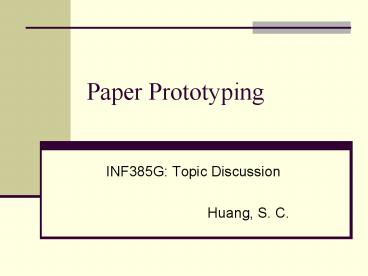Paper Prototyping - PowerPoint PPT Presentation
1 / 22
Title:
Paper Prototyping
Description:
Paper: materials of paper-and-pencil alike. Prototyping: The design and evaluation of the concept. ... 'Paper prototyping is a variation of usability testing ... – PowerPoint PPT presentation
Number of Views:328
Avg rating:3.0/5.0
Title: Paper Prototyping
1
Paper Prototyping
- INF385G Topic Discussion
- Huang, S. C.
2
Contents
- Introduction
- Methods, Tips, Things to know
- My experience
- In-class Exercise
- Conclusion
3
What is Paper Prototyping?
- Paper materials of paper-and-pencil alike.
- Prototyping The design and evaluation of the
concept. - Paper prototyping is a variation of usability
testing where representative users perform real
tasks by interacting with a paper version of the
interface.
4
Examples
5
Why Use Paper Prototyping?
- Jakob Nielsens recommendation
- Simple and Immense
- Save Money
- A method lives longer than you think
6
Words from Professionals
- User Interface Engineering
- Still the Simplest
- A Team-Building Tool
- A Design and Testing Tool
- A Communication Tool
- Facilitates Regular Testing (valuable long-term
benefit!)
7
Words from the Book Author
- Carolyn Snyder
- Fast mockup no coding required
- Finds problems, including serious ones
- Refines design base on user feedback before
implementation (Risk Management!) - Team and communication tool
- Encourages creativity!
8
Benefits Summary
- Quick to build/refine, thus enabling rapid design
interactions. - Requires minimal resources and materials.
- Detects usability problems at a very early stage
before implementation. - Promotes communication between stakeholders.
9
How and What to do
- Signs of using paper prototyping
- Stages of planning
- Run the test
- Executive Overview
10
Six Signs
- Sign 1 There are many different ideas about the
design. - Sign 2 You find yourself depending a particular
design. - Sign 3 There are parts of the design youre
unsure about.
11
Six Signs Part II
- Sign 4 Youre changing the way that the users
perform a task. - Sign 5 The concepts or terminology are new to
the users. - Sign 6 Youre feeling uncreative.
12
Four Stages
- Stage 1 Concept Design
- to explore different metaphors and design
strategies. - Stage 2 Interaction Design
- to organize the structure of screen or pages.
13
Four Stages Part II
- Stage 3 Screen Design
- for initial design of each individual screen.
- Stage 4 Screen Testing
- to refine the screen layout.
14
How to Test a Paper Prototype
- Standard Usability Evaluation Procedure.
- People you need real users, the computer, the
facilitator, the observer, and usability
consultants. - Laboratory settings.
15
Executive Overview
- Kickoff meeting
- User recruitment
- Task design
- Prototype creation and walkthroughs
- Usability testing and iterative refinement
- Prioritizing issues and action plan
- Communication of results
16
My Experience
- Paper Prototyping of Menu Design Theories on a
Small Screen Device - Mockup design was fast and flexible.
- Data of path-finding behavior was visible.
- Excluded variables we didnt want.
- Its fun!
17
In-class Exercise
- Objectives prototype a layout design of a cell
phones home menu. - Menu items to be included indicators of signal,
ringing style, and battery life date and time
up to 9 options that users perform frequently. - The menu design should be functional with your
panel layout.
18
In-class Exercise Part II
- Describe a user task to be perform on this paper
version of your design. - Test it with the person next to you.
- Ideas and comments are welcome.
19
Conclusion
- Findings that make paper prototyping valuable
- Usability issues
- Missing (or mis-specified) functional
requirements - Preference for one design alternatives
- Priorities
- Issues outside the user interfaces
20
Again, Benefits Summary
- Quick to build/refine, thus enabling rapid design
interactions. - Requires minimal resources and materials.
- Detects usability problems at a very early stage
before implementation. - Promotes communication between stakeholders.
21
Questions?
- Thank you.
22
References
- Five Paper Prototyping Tips
- Matthew Klee, 03/01/2000
- http//www.uie.com/articles/prototyping_tips/
- Paper Prototypes Still Our Favorite
- Tara Scanlon, 05/01/1998
- http//www.uie.com/articles/paper_prototyping/
- Paper Prototyping Getting User Data Before You
Code - Jakob Nielsen, April 14, 2003
- http//www.useit.com/alertbox/20030414.html
- Paper prototyping
- Usability Net
- http//www.usabilitynet.org/tools/prototyping.htm
- Paper Prototyping The Fast and Easy Way to
Design and Refine User Interfaces - Carolyn Snyder
- http//www.paperprototyping.com/
- Six Signs That You Should Use Paper Prototyping
- Carolyn Snyder 12/23/2003
- http//today.java.net/pub/a/today/2003/12/23/sixS
igns.html - Using Paper Prototypes to Manage Risk

